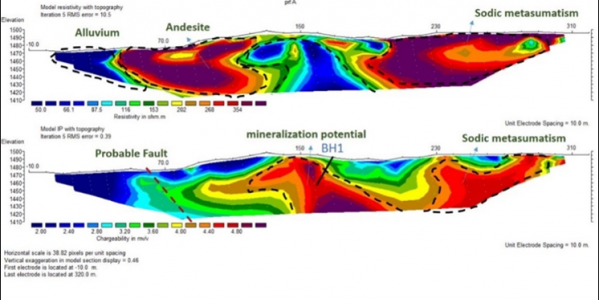Study of environment and mineralizing control factors (deposit type) of Soheil-Abad deposit in Naein ophiolite sequence (Isfahan), an approach for gold, copper and iron exploration

Executor of project: Dr. Seyed Mehran Heidari
2021
The Iron-copper-gold study area ocurence located in 30 km north of Naeen city, 5 km from Soheil village of Isfahan province, in central Iran and the middle part of the Urumieh-Dokhtar magmatic belt. Based on geodynamic setting,, although this area is a part of the Zagros orogenic belt and corresponds to the active margin and magmatic arcs. But mostly of lithology unit outcrops in this area related to the Cretaceous-Paleocene Naeen ophiolitic sequence, which formed in the extentional environment (rift) and cut by Upper Eocene-Oligocene intrusive rocks. Tectono-magmatic phases in the region are including of the continuous spectrum of subduction to collision magmatic activities, that provide ideal conditions for the formation of hydrothermal-magmatic deposits (intrusion related) in this area (Kahang, Kooh-dom, Zafarghand).
The mineral deposit is determined by the anomaly of elements such as iron, copper, gold, bismuth, cobalt and possibly rare earth elements (due to the presence of apatite). Iron (copper) veins in this area formed within the diorite-gabbrodiorite intrusives and copper-gold ores in the form of veins-veinlets within a set of rocks with spilit, andesite and Basalts combination, which belonging to the upper part of the ophiolite sequence. These veins are often controled by strike slip faults (right-left) with northwest-southeast to east-west trending and space filling, massive, breccia, strip, cloform textures. The hydrothermal alteration of this mineralization includes of silicification, argillic, sericitic, albite, calcic, iron oxide and propylitic or chloritization. Between, siliceous-sericite alterations is together with mineralization, sodium/ calcic alteration which have the highest expansion in the region is in the vicinity and with distance from the ore veins and finally quartz-calcite-chlorite alteration that occurred with distance. In general, the development of hydrothermal-magmatic mineralization for this event can be summarized in three stages, which include 1- Quartz-magnetite-hematite-apatite-sulfide veins (pyrite and rarely chalcopyrite) 2- Quartz-sulfide veins (Chalcocite, chalcopyrite, covelites and rarely pyrite (with gold), 3-quartz-calcite veins with open space and cavities filling texture. In general, according to the tectonic setting, the environment of the formation of the host rock type and the occurrence of hydrothermal-magmatic mineralization in the Soheil Abad area, this mineralization can be in the form of hydrothermal-magmatic deposits of IOA type (northern part) and mantle (Southern part), which are associated with iron-copper-gold-related to intrusions in subduction zones.









